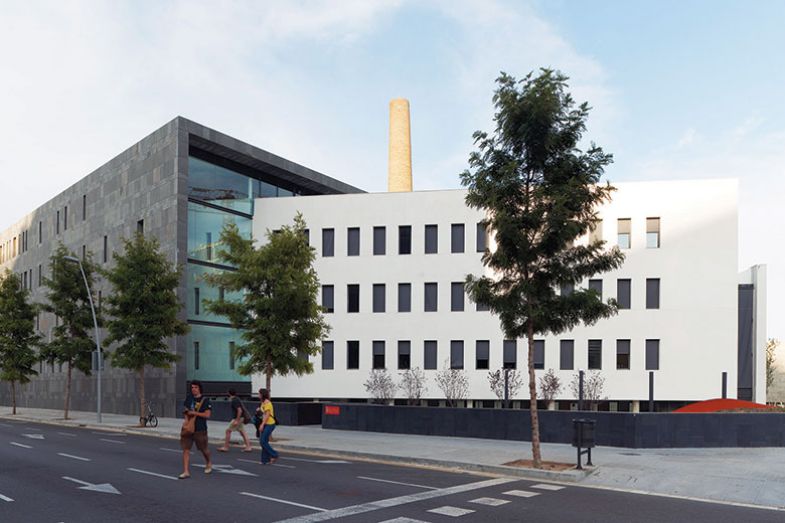Browse the THE Young University Rankings 2020 results
One advantage of youth is that you start with the wisdom that your predecessors worked hard to build. For fledgling universities, that hindsight can shape the way they see the world and seek to improve it.
When Pompeu Fabra University (UPF) was established in 1990 in Barcelona, a city that had seen its share of turmoil, its founders had in mind a different mission from the function embraced by the wave of universities that preceded it.
The autonomous universities of Madrid and Barcelona and the University of Bilbao (now the University of the Basque Country), all created 22 years earlier, were established in the outskirts of their host cities to help keep Francoist Spain’s power centres clear of student activists. Pompeu Fabra, by contrast, was “deliberately” located in inner-city neighbourhoods beset by social strife.
“From the beginning, we were an urban university,” says Josep Lluís Martí, the institution’s vice-rector for innovation projects. “We had this role of working as a catalyser for social activities. Being young helps. It allows [you] to start from scratch, and maybe develop more sensitivity about social issues.”
Pompeu Fabra and other Spanish institutions established at about the same time were preoccupied with different challenges from their predecessors, who were busy “fighting for democracy and freedom”, Martí says.
“We were born when Spain was already a member state of the European Union. We took democracy for granted. We didn’t have to fight for it,” he adds.
A new wave of universities emerged at about the same time on the other side of the planet in a revolution not against a dictatorship but a university elite. In Australia, reforms by John Dawkins, who was then education minister, saw teaching colleges and institutes of technology resurrected as full-blown universities.
The new institutions emerged with a “social conscience” never envisaged for the “sandstone” universities of the 19th century, according to David Lloyd, vice-chancellor of the University of South Australia (UniSA). For example, UniSA’s founding legislation includes a commitment to educate Aboriginal people.
“The evolution of new universities creates a different social outlook,” Lloyd says. “We’ve got the highest percentage of first-in-family attendees in the state, because we’re the new university.”
The changes also spawned a different research culture because UniSA and other Dawkins-era universities arrived without “established research maturity”, says Lloyd, a former bursar at Trinity College Dublin, which is 399 years older than his current charge.
“At UniSA, you had an institute of technology and a college of advanced education coming together with two very different cultures,” Lloyd says. “A new culture was inevitable.”

Many of these new universities – including Charles Sturt, Southern Cross, Edith Cowan and the University of Canberra (UC) – evolved from colleges of education.
“They were very closely engaged with their local communities because they were the institutions that provided the nurses, the physiotherapists, the teachers, the allied health professionals,” says Canberra’s interim vice-chancellor, Belinda Robinson.
“As they moved more into the research space, it made sense to continue serving local needs by building capability around research that was aligned to the specific needs of the community.”
That focus also persists in Canberra’s teaching, Robinson says. “On any given day, 50 or 60 of our health students are on placement. Go into a hospital in Canberra and our region more broadly, and everyone you see is a UC graduate or student. You can see the contribution [of] a university that prides itself in being embedded in our community.”
The University of Technology Sydney, which evolved in 1988 from an institute of technology, began rejigging its programmes about five years ago. It started inserting entrepreneurial experiences into its degrees after 40 per cent of its students said they wanted the skills to create their own career pathways.
“Every single faculty just started doing it,” says vice-chancellor Attila Brungs. “In older universities, you’d have to spend time persuading people why it was important. One of the great strengths of universities is that they are collegiate communities. But when collegiate communities do the same thing for decade after decade, there tends to be a bit of inertia.”
Brungs says that while social justice is a focus for all universities, it is “more top of mind” in younger institutions. Older universities help society “by osmosis”, with an assumption that their research will “have impact at some point in time. We don’t have that luxury because as a young university you often have more pressure to demonstrate your contribution.”
Auckland University of Technology (AUT) vice-chancellor Derek McCormack says younger universities have emerged into a “different world” from their more established counterparts.
“They sort of have to fight for their place,” he says. “By force of circumstance, we’re much more open to the external forces of opinion and demand. It’s not how good you are, but what use you are. The mortar hasn’t set yet on our procedures and culture.”
AUT has increased its standing in Times Higher Education’s World University Rankings every year since its 2016 debut, against a flat or declining performance by six of New Zealand’s other seven universities (the University of Canterbury is the only exception). It has leaped from 51st place to 40th in this year’s Young University Rankings despite being “outside the club on research funding panels” and routinely overlooked for government research contracts, McCormack says.
But while “our youth would go against us” from a rankings perspective, it also has its advantages. “Because you’re new, you don’t necessarily have any prestige to protect. Preserving your cultural endowment and reputation isn’t something you’re on about. We have to take risks to get anywhere,” he says.
Queensland University of Technology (QUT) vice-chancellor Margaret Sheil says the “weight of expectations” can act as a handbrake on more established universities.
“They’ve got alumni in positions of power and influence. The old school tie expectations make it harder to develop new missions,” she says.

As an example, Sheil cites the University of Melbourne’s adoption of generalist undergraduate courses with professional training at postgraduate level – a rare departure from type for an Australian university, which has coincided with Melbourne’s national domination of the league tables. The change meant that the undergraduate pathway to prestigious courses such as law vanished, increasing the number of years of studying for many students. “[It] was a huge effort taking the stakeholders with them,” she says. “People were saying, ‘How’s little Joey going to get into law?’ Nobody’s worried how people get into law at QUT, because it started in a different way.”
Vin Massaro, a professorial fellow at the Melbourne Centre for the Study of Higher Education, says that without the weight of tradition and reputation holding them back¸ young universities find it easier to innovate. But he questions their ability to rapidly implement their new ideas.
“There’s always the whole panoply of committees and all the other things you still need to take into account,” he says. “Otherwise, people are going to start questioning the academic value of what you’re trying to do.”
Massaro says young universities’ edge is as much about location as age.
“The newer ones have been set up in places where there’s a community need for something like [what they offer],” he reasons, but that advantage erodes over time. For example, the land-grant universities of the US were created in the 19th century to serve communities that have since “changed around them”.
But fuelled by their fast-growing communities, the land-grant universities were able to expand well beyond their original raisons d’être and become “a totally different type of institution”, Massaro says.
South Korea’s leading entry in the Young University Rankings, the Korea Advanced Institute of Science and Technology (KAIST), is on a similar trajectory as it eyes its 50th birthday next year.

“We will not be a young university any longer,” concedes KAIST president Shin Sung-Chul, whose 2018 institutional strategy “Vision 2031” sets a “more global” charter.
“We have shifted our mission to serve the community beyond Korea. This will allow us to contribute to social justice around the globe as well as in Korea,” he says.
Proving that the vision is more than words, KAIST – founded on a loan from the US Agency for International Development – is helping to establish a graduate university in Kenya, backed by a loan from the Korean government. Perhaps Kenya-KAIST will top the Young University Rankings 2070.
POSTSCRIPT:
Print headline: Usefulness is bred in the bone
Register to continue
Why register?
- Registration is free and only takes a moment
- Once registered, you can read 3 articles a month
- Sign up for our newsletter
Subscribe
Or subscribe for unlimited access to:
- Unlimited access to news, views, insights & reviews
- Digital editions
- Digital access to THE’s university and college rankings analysis
Already registered or a current subscriber? Login








